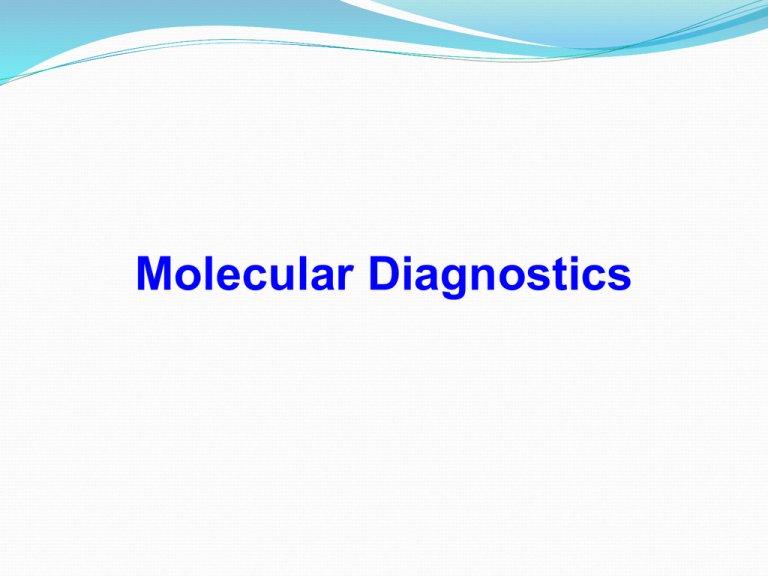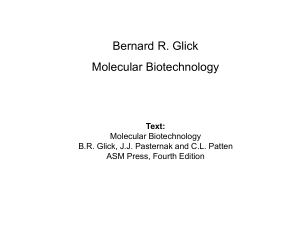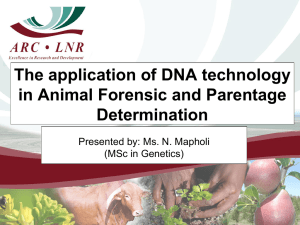Chapter 9
advertisement

Molecular Diagnostics Molecular Diagnostics Success in modern medicine and agriculture depends on the ability to detect specific viruses, bacteria, fungi, parasites, proteins, and their products in the samples. The effective prevention, control, and treatment of infectious diseases is facilitated by early and accurately detection and identification of the causative agent. Traditional methods for this entail the isolation and cultivation of the agent, and analysis of physiological properties. This can be time consuming, and ineffective if the pathogen does not grow well in culture. Ex. Chlamydia trachomatis-common in STD-will only grow in culture given long incubations. To overcome this major constraint, molecular diagnostic procedures using immunology and DNA technology have been devised. In general, these methods must be specific, sensitive, and simple. Immunological methods Used for a wide variety of applications including drug testing, cancer detection, metabolite identification, pathogen identification, and monitoring infectious agents. Traditional pathogen identification usually involves a process of elimination through biochemical tests for the presence of specific molecules. The uses of antibodies has revolutionized this process. ELISA Enzyme-linked immunosorbent assay. Uses a primary antibody against a target antigen to be detected. Detection depends upon efficient binding and substrate conversion. In this method, a sample(s) being tested is coated onto a support such as a microtiter plate. A blocking solution is added to prevent background. A primary antibody against our antigen of interest is added and allowed to bind, and is then washed to remove unbound antibody. A secondary antibody with a bound enzyme is added to detect the binding of the primary antibody. The colorless substrate for the enzyme is added, and the absorbance of the colored product is measured. Used for drug testing, monitoring cancers, metabolites, pathogen identification, monitoring infectious agents (human, animal, plant), etc. Antibodies produced by injection of an antigen into an animal. The resulting antibody mixture found in the serum are polyclonal. They recognize multiple antigenic epitopes on the molecule in question. Most of the time these work well for ELISA. Two drawbacks are:(1) the amount of the antibodies may vary from batch to batch and (2) cross reaction may occur between the target and nontarget. The surface of the antigen depicted has 7 different antigenic determinants (epitopes). When immunized, each epitope elicit the synthesis of different antibody. Together, they constitute a polyclonal antibody. Monoclonal Antibodies To produce monoclonal antibodies, a researcher need to create a cell line that could be grown in culture and that would produce a single type of antibody molecule with high affinity for a specific target antigen. Unfortunately, the B lymphocytes do not reproduce in culture. The hybrid cell would have the B cell genetic components to produce the antibody but can grow in culture. Myeloma cells (cancerous B lymphocytes) became candidate for cell fusion. To produce monoclonal antibodies, animals are injected with the antigen, and their spleens are collected. Spleens are macerated, resuspended, and mixed with myeloma cells that have a metabolic deficiency for the enzyme hypoxanthine-guanine phosphoribosyl transferase (HGPRT-). Polyethylene glycol is added to facilitate fusion. Fused cells are grown on a selective medium (HAT) which allow only the myeloma-spleen fusion cells to grow. About 10 – 14 days post fusion treatment, the spleen-myeloma fusion cells are then grown on complete medium in microtiter plates. Fused cells must be screened for the production of the specific antibody using the culture medium, which contains secreted antibodies, in immunoassay. The identified cells are maintained and used for antibody production. Isolated antibodies are conjugated to the enzyme for ELISA, increasing specificity since only one epitope is recognized. Biofluorescent and Bioluminescent Systems Bioassay for potentially toxic compounds. The gene is placed under the promoter that responds to certain environmental signal. Colored Fluorescent Proteins Green fluorescent protein. The 238-amino-acid-long GFP isolated from the jellyfish Aequorea victoria, fluoresces green when exposed to UV light. The incorporation of green fluorescent protein into cells allow intact living cells to be monitored in real time. The use of this reporter molecule has revolutionized fluorescence microscopy. Colored Fluorescent Proteins Red fluorescent protein. Isolated from the Discosoma coral, and by means of multiple random mutations, generated a mutant that existed as a monomer. A modified monomeric red fluorescent protein is constructed. The constructed then became the starting point for several additional rounds of random mutagenesis. Eventually, seven different monomeric colored fluorescent proteins were produced. Luciferase The luciferase enzyme, which catalyzes a light-emitting reaction. Luciferase genes from bacteria are termed lux genes, while those from firefly are termed luc genes. The lux system produces a peak of light at 490 nm, no additional compounds need when all 5 genes are used. The luc system results in production of light at 55- to 575 nm, luciferin is needed as a substrate for the light reaction. Microbial Biosensors Need for bioassay for potentially toxic compounds in the environment. Often constitutively bioluminescent bacteria are good candidates for pollutant detectors. Vibrio fisheri - bioluminescent marine bacteria have limit utility because of very specific saline and pH requirements. Lux genes can however be transferred to other more useful soil bacerium, such as Pseudomonas fluorescens. The engineered yeast is used to detect low levels of estrogenic substances in the environment. Nucleic Acid Diagnostic System DNA hybridization probes provide rapid and reliable assays. Most often a probe is developed to recognize a specific gene carried by a pathogen. Bind single-stranded DNA target to a membrane support. Add single-stranded labeled DNA probe under appropriate conditions. Wash the membrane to remove excess unbound probe. Detect the hybrid sequences (target-probe). Nucleic Acid Diagnostic System DNA probes for this process must be specific and not recognize non-target organisms. Towards this end, probes usually use a gene or gene variant specific to the organism being investigated. Cross hybridization with other species must be rigorously tested to eliminate false positives. Hybridization conditions must be optimized. Nucleic Acid Diagnostic System Probes for diagnosis of a variety of diseases have been developed. Includes a test for the malarial parasite Plasmodium falciparum. Traditional detection looks for the parasite in blood smears which is time-consuming. ELISA can work, but they do not always discriminate between current and past infection. Repetitive DNA probes were isolated that specifically detect only P. falciparum. Nucleic Acid Diagnostic System Over 100 such tests have been developed for human pathogenic strains of bacteria, viruses, and parasites. These include: Legionella pneumophila, Salmonella typhi, Campylobacter hyointestinalis, and the enterotoxic E. coli. Nucleic Acid Diagnostic System Detection of Trypanosoma cruzi in Chagas disease uses different technology. Traditional detection here uses a blood smear or blood fed to uninfected insect vectors. Both tests are laborious, time-consuming, and costly. ELISA can be used but often gives false positives. A set of PCR primers was developed that allows for detection of a 188 bp fragment that is present in mutiple copies in T. Cruzi but absent in others. Many pathogens are detected using the same approach including HIV, and tuberculosis. Nonradioactive Hybridization Most commonly, detection using Southern hybridization methods uses radioactively labeled probes. This has the advantage of probes that have high specific activity. The disadvantages include short-lived probes, potentially dangerous, and special handling and disposal equipment. As a result, non-radioactive detection methods have been developed. Nonradioactive Hybridization One of the most common methods uses DNA probes that have been biotinylated. Biotin binds very tightly with a protein from bacterium Streptococcus called streptavidin. Detection often uses enzymes that are either conjugated to streptavidin or are biotinylated themselves. Enzymes used include horseradish peroxidase or alkaline phosphatase Nonradioactive Hybridization Another early PCR method for detection uses fluorescently labeled primers. After PCR amplification, the primers are separated from the amplification product and the presence of label is detected. If the target DNA is not present in the sample, then no fluorescent product will be observed. The system is sensitive and quite rapid, since it is not necessary to run a gel to separate the amplify target DNA. Molecular Beacons Molecular beacons are a novel non- radioactive detection mechanism. The probe is 25 nucleotides long. The 15 nucleotides in the middle are complementary to the target DNA. A fluorescent molecule (fluorophore) is attached to 5’ end and a non-fluorescent molecule (quencher) is attached to 3’ end. When hybridized, the reporter dye fluoresces, and can be detected. An improvement on this is real time PCR with the same sort of molecular beacon probes. Molecular-beacon probes with different fluorophores that complement to a different target DNA. Can also be used to distinguish homo vs heterozygotes. DNA fingerprinting Distinguishing individuals with DNA analysis is called DNA fingerprinting (DNA typing). The DNA from a sample left at the crime scene can be analyzed and compared with the suspects’ DNA to help in prosecution. It can be used to determine paternity and identify victims from disasters. PCR or RFLP DNA fingerprinting Probes for hybridization in forensic samples consists of human minisatellite DNA. This DNA is repetitive and extensively variable from one person to the next. The length of the repeats range from 9 to 40 bp, and the numbers of the repeats in the minisatellites range from about 10 to 30. Southern blot of a forensic DNA sample. RAPD Randomly Amplified Polymorphic DNA This technique uses PCR with random sets of primers, 9-10 bases long. The primers are not directed at any particular sequence. As short sequence, it will pair with the chromosomal DNA at many sites. When the 3’ ends of the oligonucleotides on opposite strands of the DNA face each other, the DNA in between can be amplified. RAPD RAPD There is a number of advantages. The universal set of primers can be used for all plant species. It is fast, easy, and repeatable. A large number of samples may be easily and rapidly characterized since there is no hybridization required. The process can be automated. It has been done successfully in many systems. Real-Time PCR By labeling the amplified DNA with a fluorescent dye that is irradiated with light of a certain wavelength, it is possible to watch the production of PCR product in “real-time.” It is also can be used to quantify the amount of a specific DNA fragment in the starting material. Different technologies available. SYBR green and TaqMan. The SYBR green does not bind to single- stranded DNA. Only the bound DNA fluoresces. A plot of ΔRn (normalized fluorescence) versus cycle number in real-time PCR experiment. Four phases of PCR are shown. The cycle in phase two is known as CT. A standard curve is first generated by serially diluting a sample with known number of copies of target DNA. The CT values for each dilution are plotted against the starting amount of sample. Immunoquantitative real-time PCR Combines specificity of antibodies and the sensitivity of real-time PCR. Ancestry Determination Uses single nucleotide polymorphisms (SNPs) Commonly used autosomal DNA, the Y chromosome, and maternal DNA (chromosome X and mitochondrial DNA) Table 9.3 summarizes the current mitochondrial DNA haplotypes and the ethnic groups associated with these haplotypes. The results are often misinterpreted because of the gene flow and the genetic diversity within the populations. Animal Species determination For endangered species and illegal trafficking Method uses PCR of animal’s cytochrome b gene followed by sequencing. Automated DNA Analysis It is necessary to rapidly identify the organism(s) that is the source of infectious outbreak. Combination of PCR and electrospray ionization mass spectrometry are performed. DNA sequences of a large numbers of microbes have been determined. Molecular Diagnosis of Genetic Disease Previously, genetic testing relied most exclusively on biochemical assays that scored either the presence or absence of a gene product. Test at the DNA level are definitive for determining the existence of specific gene mutations. It is possible to develop screening assays for all single-gene diseases. Molecular Diagnosis of Genetic Disease Screening for cystic fibrosis: CF results from mutations in cystic fibrosis transmembrane conductance regulator (CFTR) gene, resulting in defects in chloride ions transport. There are nearly 1,400 known mutations that can cause cystic fibrosis. Some mutations are much more prevalent than others (Table 9.4). The allele ΔF508 can be used for diagnosis. Molecular Diagnosis of Genetic Disease Molecular Diagnosis of Genetic Disease Molecular Diagnosis of Genetic Disease Sickle cell anemia: Occurs as the result of a single nucleotide change in the codon for the sixth amino acid of the β chain of hemoglobin (Glu to Val.) Homozygous individuals develop severe anemia resulting in progressive organ damage as a result of an inability to carry oxygen. Heterozygous individuals mostly normal except especially under conditions of low oxygen tension (high usage or altitude). Molecular Diagnosis of Genetic Disease Screening can be done quite simply since the mutation destroys a restriction enzyme site. PCR is used to amplify the region which can then be digested and electrophoresed. Normal individuals have the site and produce a different fragment pattern than sickle cell individuals. Molecular Diagnosis of Genetic Disease Unfortunately, not all single nucleotide changes effect restriction sites so other types of assays must be developed for detection. One of these is called PCR/OLA (oligonucleotide ligation assay). First, the sequence is amplified by PCR. Next, a pair of oligonucleotide probes are annealed (one is biotinylated and the other is digoxigenated) to either side of the susceptible site. Molecular Diagnosis of Genetic Disease DNA ligase is added. If no mutation exists, ligation occurs, but not if there is a mutation. The products are then allowed to bind to a streptavidin coated plate, and antidigoxygenin antibody are added. The antibody is enzyme linked and produces a color in presence of the substrate if bound. The PCR/OLA system is rapid, sensitive, and highly specific. Molecular Diagnosis of Genetic Disease A similar technique uses a padlock probe. In this case, the 5’ & 3’ ends of a probe are complimentary to the sequence and anneal in close proximity. DNA ligase is added and ligation can take place. If there is mutation, then, there is no ligation and hybridization. Unligated probe will be remove by washing. Ligated probe can be detected as still bound using reporter tags or ELISA. Molecular Diagnosis of Genetic Disease Detection of a single-base mutation can also be done by fluorescent-labeled PCR. Amenable to real-time PCR. A primer for the wild type sequence is used which ends with at commonly mutated nucleotide. Wild-type DNA gives a product & mutant does not. The reverse assay for the mutant can also be used with different fluorescent color. Molecular Diagnosis of Genetic Disease TaqMan Assay. Taqman probe, complementing to wild-type DNA is added prior to the PCR. The probe contains fluorescent dye and quencher at 5’ end and 3’ end, respectively. In the extension phase of PCR, the Taqman probe is replacing by the synthesizing strand. Subsequently, the 5’ fluorescent dye is cleaved by the 5’ nuclease activity of the Taq polymerase, leading to the increase of the fluorescent dye.









